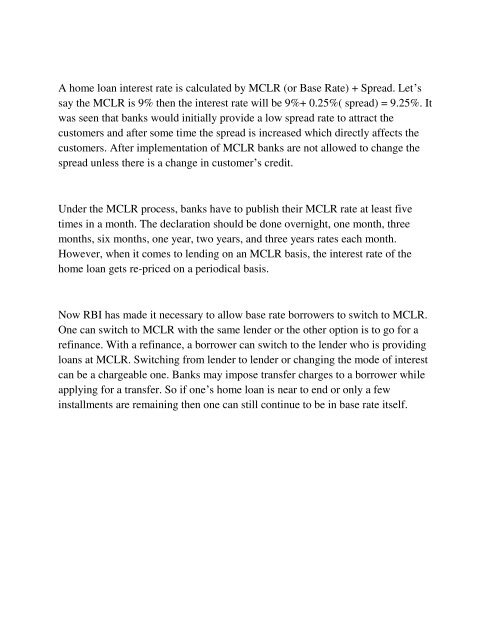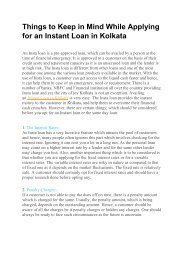RBI Guidelines on MCLR 2018
There is a lot of buzz in the news that the RBI has instructed all the banks to synchronise Base rate with MCLR by April 2018. It means all the home loan borrowers including pre-2016 borrower’s loan will be transferred to MCLR rate from the base interest rate. Blog: https://amritaagarwalblog.wordpress.com/2018/02/08/rbi-guidelines-on-mclr-2018/ Apply for Loan: https://financebuddha.com/home-loan Facebook :https://www.facebook.com/financebuddha Twitter:https://twitter.com/financebuddha
There is a lot of buzz in the news that the RBI has instructed all the banks to synchronise Base rate with MCLR by April 2018. It means all the home loan borrowers including pre-2016 borrower’s loan will be transferred to MCLR rate from the base interest rate.
Blog: https://amritaagarwalblog.wordpress.com/2018/02/08/rbi-guidelines-on-mclr-2018/
Apply for Loan: https://financebuddha.com/home-loan
Facebook :https://www.facebook.com/financebuddha
Twitter:https://twitter.com/financebuddha
You also want an ePaper? Increase the reach of your titles
YUMPU automatically turns print PDFs into web optimized ePapers that Google loves.
A home loan interest rate is calculated by <strong>MCLR</strong> (or Base Rate) + Spread. Let’s<br />
say the <strong>MCLR</strong> is 9% then the interest rate will be 9%+ 0.25%( spread) = 9.25%. It<br />
was seen that banks would initially provide a low spread rate to attract the<br />
customers and after some time the spread is increased which directly affects the<br />
customers. After implementati<strong>on</strong> of <strong>MCLR</strong> banks are not allowed to change the<br />
spread unless there is a change in customer’s credit.<br />
Under the <strong>MCLR</strong> process, banks have to publish their <strong>MCLR</strong> rate at least five<br />
times in a m<strong>on</strong>th. The declarati<strong>on</strong> should be d<strong>on</strong>e overnight, <strong>on</strong>e m<strong>on</strong>th, three<br />
m<strong>on</strong>ths, six m<strong>on</strong>ths, <strong>on</strong>e year, two years, and three years rates each m<strong>on</strong>th.<br />
However, when it comes to lending <strong>on</strong> an <strong>MCLR</strong> basis, the interest rate of the<br />
home loan gets re-priced <strong>on</strong> a periodical basis.<br />
Now <str<strong>on</strong>g>RBI</str<strong>on</strong>g> has made it necessary to allow base rate borrowers to switch to <strong>MCLR</strong>.<br />
One can switch to <strong>MCLR</strong> with the same lender or the other opti<strong>on</strong> is to go for a<br />
refinance. With a refinance, a borrower can switch to the lender who is providing<br />
loans at <strong>MCLR</strong>. Switching from lender to lender or changing the mode of interest<br />
can be a chargeable <strong>on</strong>e. Banks may impose transfer charges to a borrower while<br />
applying for a transfer. So if <strong>on</strong>e’s home loan is near to end or <strong>on</strong>ly a few<br />
installments are remaining then <strong>on</strong>e can still c<strong>on</strong>tinue to be in base rate itself.


















